2014 PEUGEOT 5008 lock
[x] Cancel search: lockPage 98 of 404
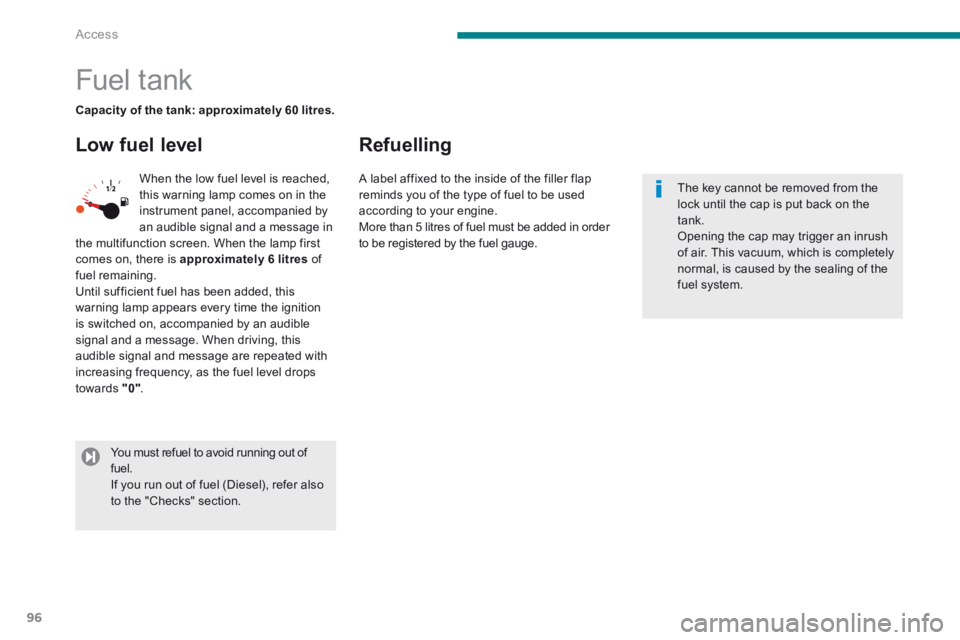
Access
96
Fuel tank
Low fuel level Refuelling
When the low fuel level is reached, this warning lamp comes on in the instrument panel, accompanied by
an audible signal and a message in the multifunction screen. When the lamp first comes on, there is approximately 6 litres of fuel remaining. Until sufficient fuel has been added, this warning lamp appears every time the ignition is switched on, accompanied by an audible signal and a message. When driving, this audible signal and message are repeated with increasing frequency, as the fuel level drops towards "0" .
Capacity of the tank: approximately 60 litres.
The key cannot be removed from the lock until the cap is put back on the tank. Opening the cap may trigger an inrush of air. This vacuum, which is completely normal, is caused by the sealing of the fuel system.
You must refuel to avoid running out of fuel. If you run out of fuel (Diesel), refer also to the "Checks" section.
A label affixed to the inside of the filler flap reminds you of the type of fuel to be used according to your engine.
More than 5 litres of fuel must be added in order to be registered by the fuel gauge.
Page 107 of 404

5
Visibility105
Exterior welcome lighting
Switching on
Switching off
Programming
The lighting duration is selected via the vehicle configuration menu.
Press the open padlock on the remote control.
The dipped beam headlamps and the sidelamps come on; your vehicle is also unlocked.
The exterior welcome lighting switches off automatically after a set time, when the ignition is switched on or on locking the vehicle.
The remote switching on of the lighting makes your approach to the vehicle easier in poor light. It is activated according to the level of light detected by the sunshine sensor.
The duration of the welcome lighting is associated with and identical to that of the automatic guide-me-home lighting.
Page 116 of 404
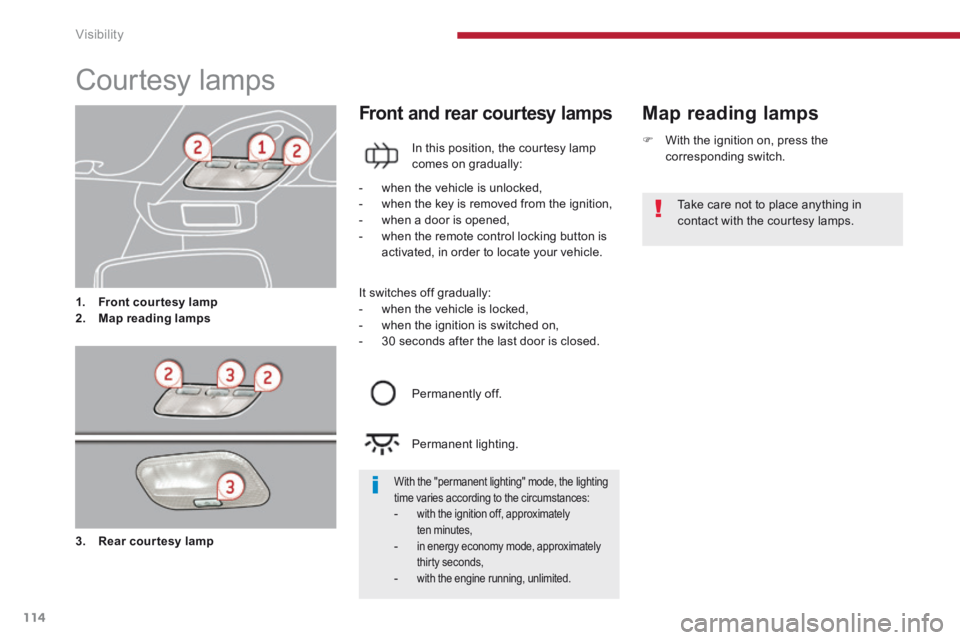
Visibility
114
Courtesy lamps
1. Front courtesy lamp2. Map reading lamps
Map reading lamps Front and rear courtesy lamps
In this position, the courtesy lamp comes on gradually:
- when the vehicle is unlocked, - when the key is removed from the ignition, - when a door is opened, - when the remote control locking button is activated, in order to locate your vehicle.
Permanently off.
Permanent lighting.
It switches off gradually: - when the vehicle is locked, - when the ignition is switched on, - 30 seconds after the last door is closed.
3. Rear courtesy lamp
Take care not to place anything in contact with the courtesy lamps.
With the "permanent lighting" mode, the lighting time varies according to the circumstances: - with the ignition off, approximately ten minutes, - in energy economy mode, approximately thirty seconds, - with the engine running, unlimited.
With the ignition on, press the corresponding switch.
Page 117 of 404
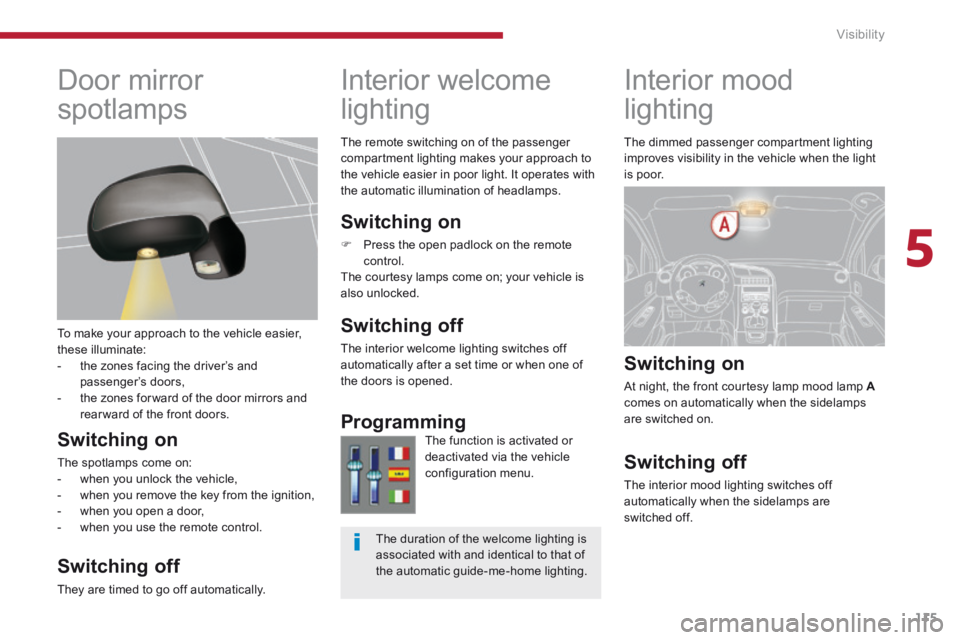
5
Visibility115
Interior mood
lighting
Switching on
At night, the front courtesy lamp mood lamp Acomes on automatically when the sidelamps are switched on.
Switching off
The interior mood lighting switches off automatically when the sidelamps are switched off.
Interior welcome
lighting
Switching on
Press the open padlock on the remote control. The courtesy lamps come on; your vehicle is also unlocked.
Switching off
The interior welcome lighting switches off automatically after a set time or when one of the doors is opened.
Programming
The function is activated or deactivated via the vehicle configuration menu.
Door mirror
spotlamps
To make your approach to the vehicle easier, these illuminate: - the zones facing the driver’s and passenger’s doors, - the zones for ward of the door mirrors and rear ward of the front doors.
Switching on
The spotlamps come on: - when you unlock the vehicle, - when you remove the key from the ignition, - when you open a door, - when you use the remote control.
Switching off
They are timed to go off automatically.
The dimmed passenger compartment lighting improves visibility in the vehicle when the light is poor.
The duration of the welcome lighting is associated with and identical to that of the automatic guide-me-home lighting.
The remote switching on of the passenger compartment lighting makes your approach to the vehicle easier in poor light. It operates with the automatic illumination of headlamps.
Page 123 of 404
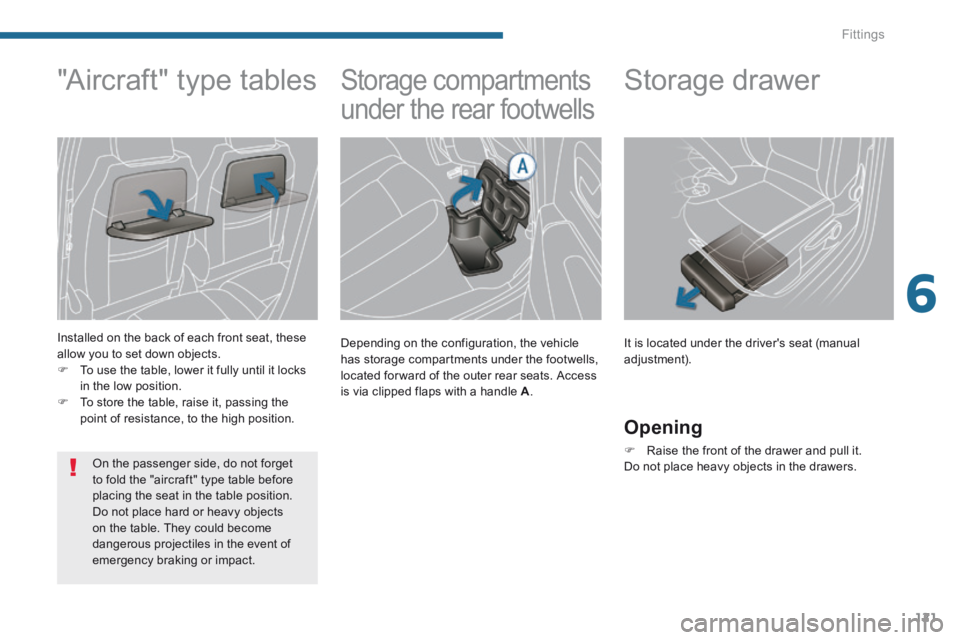
6
Fittings121
Storage compartments
under the rear footwells
Depending on the configuration, the vehicle has storage compartments under the footwells, located for ward of the outer rear seats. Access is via clipped flaps with a handle A .
"Aircraft" type tables
Installed on the back of each front seat, these allow you to set down objects. To use the table, lower it fully until it locks in the low position. To store the table, raise it, passing the point of resistance, to the high position.
Storage drawer
It is located under the driver's seat (manual adjustment).
Opening
Raise the front of the drawer and pull it. Do not place heavy objects in the drawers. On the passenger side, do not forget to fold the "aircraft" type table before placing the seat in the table position. Do not place hard or heavy objects on the table. They could become dangerous projectiles in the event of emergency braking or impact.
Page 152 of 404
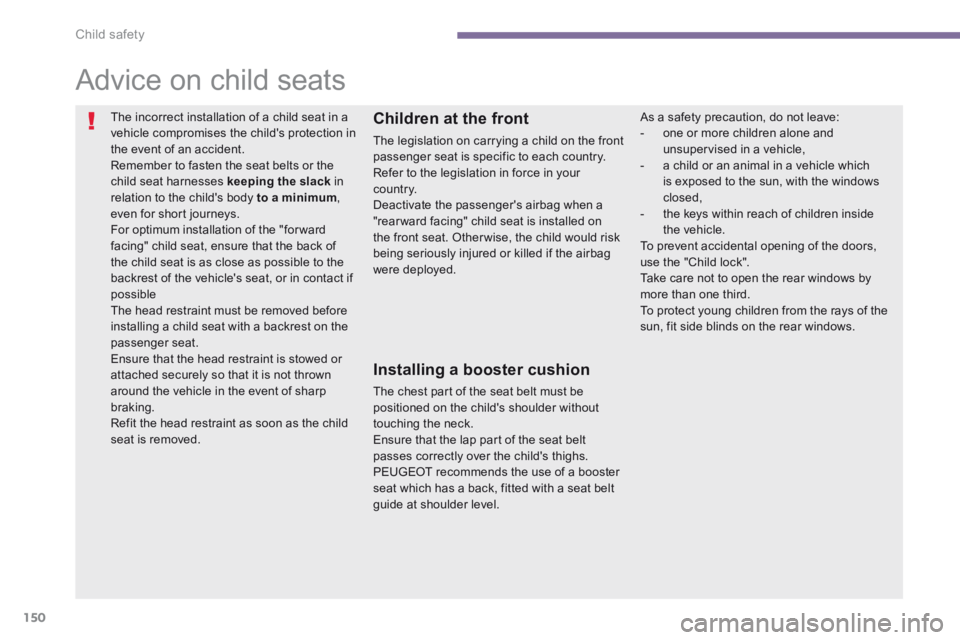
Child safety
150
Advice on child seats
The incorrect installation of a child seat in a vehicle compromises the child's protection in the event of an accident. Remember to fasten the seat belts or the child seat harnesses keeping the slack in relation to the child's body to a minimum , even for short journeys. For optimum installation of the "forward facing" child seat, ensure that the back of the child seat is as close as possible to the backrest of the vehicle's seat, or in contact if possible The head restraint must be removed before installing a child seat with a backrest on the passenger seat. Ensure that the head restraint is stowed or attached securely so that it is not thrown around the vehicle in the event of sharp braking. Refit the head restraint as soon as the child seat is removed.
Children at the front
The legislation on carrying a child on the front passenger seat is specific to each country. Refer to the legislation in force in your c o unt r y. Deactivate the passenger's airbag when a "rear ward facing" child seat is installed on the front seat. Otherwise, the child would risk being seriously injured or killed if the airbag were deployed.
Installing a booster cushion
The chest part of the seat belt must be positioned on the child's shoulder without touching the neck.
Ensure that the lap part of the seat belt passes correctly over the child's thighs. PEUGEOT recommends the use of a booster seat which has a back, fitted with a seat belt guide at shoulder level.
As a safety precaution, do not leave: - one or more children alone and unsupervised in a vehicle, - a child or an animal in a vehicle which is exposed to the sun, with the windows closed, - the keys within reach of children inside the vehicle. To prevent accidental opening of the doors, use the "Child lock". Take care not to open the rear windows by more than one third. To protect young children from the rays of the sun, fit side blinds on the rear windows.
Page 153 of 404
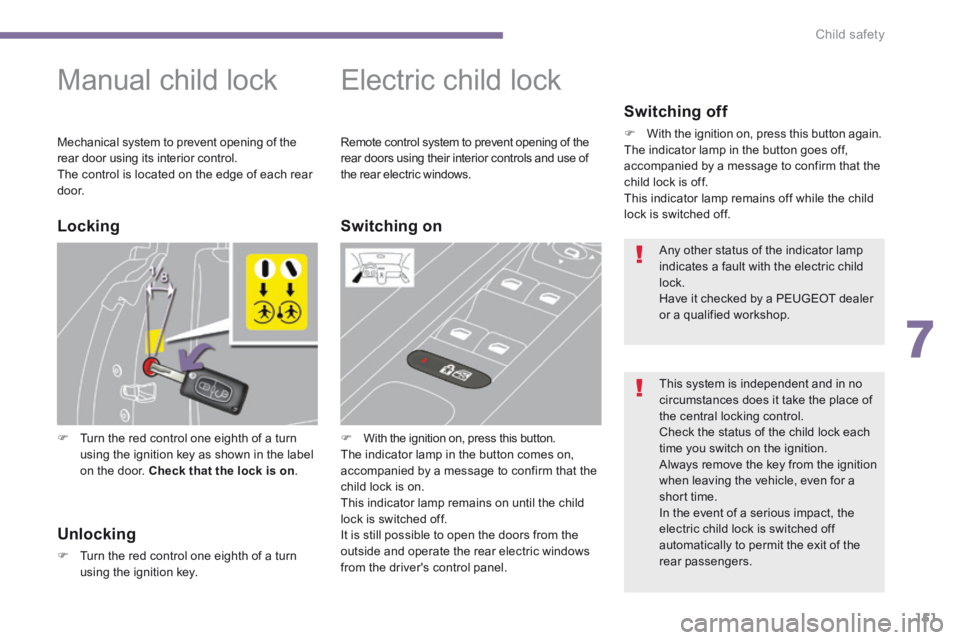
7
Child safety151
Manual child lock
Turn the red control one eighth of a turn using the ignition key as shown in the label on the door. Check that the lock is on .
Electric child lock
With the ignition on, press this button. The indicator lamp in the button comes on, accompanied by a message to confirm that the child lock is on. This indicator lamp remains on until the child lock is switched off. It is still possible to open the doors from the outside and operate the rear electric windows from the driver's control panel.
Locking
Unlocking
Turn the red control one eighth of a turn using the ignition key.
Switching on
Switching off
With the ignition on, press this button again. The indicator lamp in the button goes off, accompanied by a message to confirm that the child lock is off. This indicator lamp remains off while the child lock is switched off.
Any other status of the indicator lamp indicates a fault with the electric child lock. Have it checked by a PEUGEOT dealer or a qualified workshop.
This system is independent and in no circumstances does it take the place of the central locking control. Check the status of the child lock each time you switch on the ignition. Always remove the key from the ignition when leaving the vehicle, even for a short time. In the event of a serious impact, the electric child lock is switched off automatically to permit the exit of the rear passengers.
Remote control system to prevent opening of the rear doors using their interior controls and use of the rear electric windows.
Mechanical system to prevent opening of the rear door using its interior control. The control is located on the edge of each rear d o o r.
Page 157 of 404

8
Safety155
Electronic stability programme (ESC)
Definitions Anti-slip regulation (ASR)
The ASR system (also known as Traction Control) optimises traction in order to limit wheel slip by acting on the brakes of the driving wheels and on the engine. It also improves the directional stability of the vehicle on acceleration.
Dynamic stability control (DSC)
If there is a difference between the path followed by the vehicle and that required by the driver, the DSC monitors each wheel and automatically acts on the brake of one or more
wheels and on the engine to return the vehicle to the required path, within the limits of the laws of physics.
Emergency braking assistance
In an emergency, this system enables you to reach the optimum braking pressure more quickly and therefore reduce the stopping distance. It is triggered according to the speed at which the brake pedal is pressed. This is felt by a reduction in the resistance of the pedal and an increase in the effectiveness of the braking.
Anti-lock braking system (ABS) and electronic brake force distribution (EBFD)
This system improves the stability and manoeuvrability of your vehicle when braking and provides improved control in corners, in particular on poor or slippery road sur faces.
The ABS prevents wheel lock in the event of emergency braking. The electronic brake force distribution system manages the braking pressure wheel by wheel.
Snow driving assistance
(Intelligent Traction Control)
Your vehicle has a system to help driving on snow: Intelligent Traction Control. This automatic system continuously checks for situations of difficult sur face adhesion that could make it difficult to move off or make progress on deep fresh snow or compacted snow. In these situations, Intelligent Traction Control limits the amount of wheel slip to provide the best traction and trajectory control. In extremely severe conditions (deep snow, mud…), it can be useful to temporarily deactivate the dynamic stability control and wheel anti-slip systems to allow a degree of wheel spin and so recover grip. It is recommended that the system be reactivated as soon as possible. Snow tyres are strongly recommended on
sur faces offering low levels of adhesion.
Electronic Stability Programme (ESC: Electronic Stability Control) incorporating the following systems: - the anti-lock braking system (ABS) and the electronic brake force distribution (EBFD), - the emergency braking assistance, - the anti-slip regulation (ASR) or traction control, - the dynamic stability control (DSC).